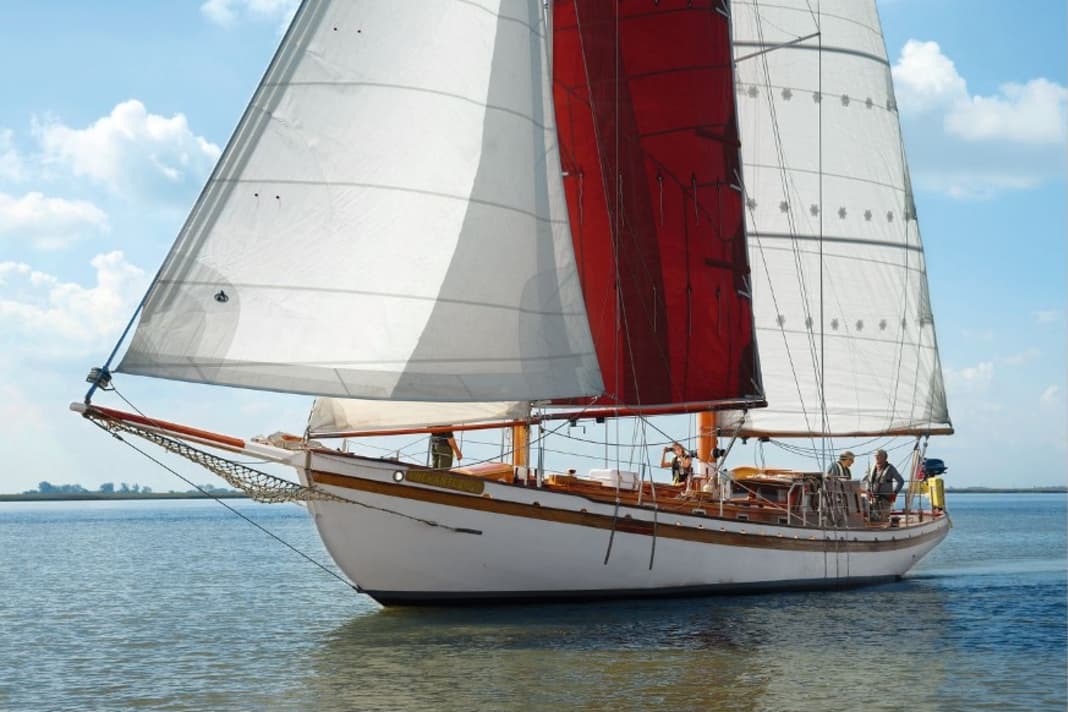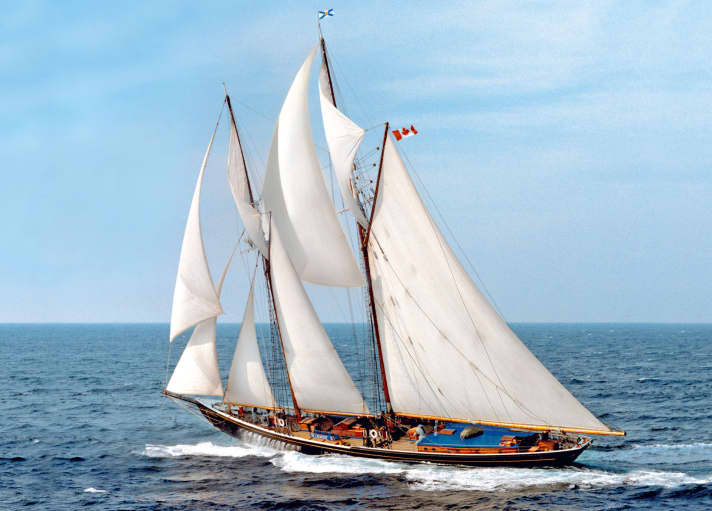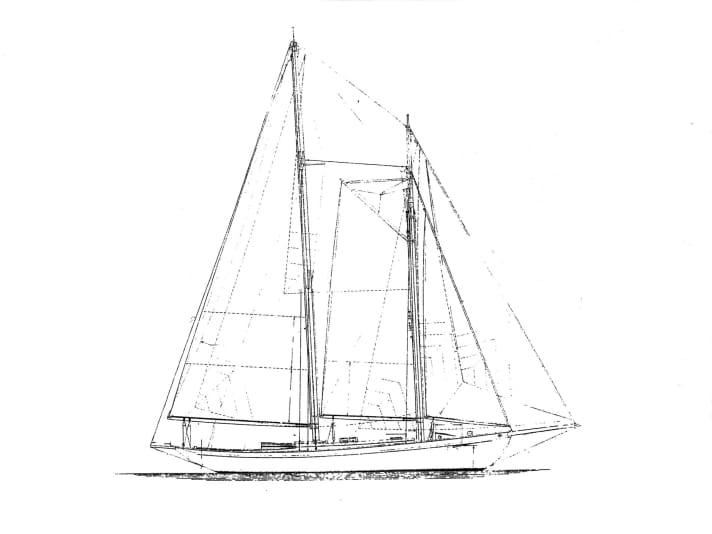





The main mast of the "Enchantress II" rises over 21 metres into the bright blue sky above Bremerhaven, the schooner mast barely less. On this windless Sunday in August, the furling jib, boom jib, gaff schooner sail and Bermuda mainsail are set - the 120 square metres of cloth slowly propel the classic wooden schooner forward. The good-natured sea behaviour of the ship can be sensed in the swell of a passing tugboat. The striking, positive deck projection, the widely overhanging stern and the relatively low freeboard of the 16 metre long hull are inevitably reminiscent of the impressive Grand Banks fishing schooners.
In fact, the 390F design by US designer John Gale Alden is based on the schooners that were originally built for cod fishing on the Grand Banks near Newfoundland. And these were not only extremely seaworthy, but also fast. As the first ship in the harbour was awarded the best prize for the fish, the crews engaged in fiercely contested races. "Captains Courageous" with Spencer Tracy created a cinematic monument to them in 1937, the first of three film adaptations of the novel by Rudyard Kipling (1865-1936). The English writer and later winner of the Nobel Prize for Literature published it in 1897, three years after his classic children's book "The Jungle Book".
Newfoundland schooners served as a model for the "Enchantress II"
John Alden was born in Troy, New York, in 1884. In 1900, his family moved to Dorchester, Massachusetts, where the Grand Banks fishing schooners were based. The ships quickly fascinated the teenager and inspired him to make countless sketches of them. In 1902, Alden began his training as a ship designer at the highly respected Massachusetts Institute of Technology (MIT).
His later characteristic design features were shaped by a voyage with a small crew on the schooner "Fame" of the Eastern Fishing Company in the winter of 1907. In winds of up to force ten and salty spray that turned to ice, Alden learnt what a seaworthy boat - and one that could be handled by a small crew - should look like. His later designs were not only praised for their grace and beauty. They were also recognised for their stability and the fact that they could generally be sailed single-handed if necessary.
Points that were also important to Klaus and Ute Rabe when they chose the Alden design for the construction of their "Enchantress II". After all, they wanted a beautiful, seaworthy ship to undertake further extended voyages, especially to the high northern latitudes.
These classic yachts are also interesting:
Many self-build projects take ages, and many are never completed. The fact that the "Bezaubernde" did not become an "unfinished one" is mainly thanks to the perseverance of the now 79-year-old owner Ute Rabe.
She came to Saxony with her mother and two older brothers in 1945 as a refugee from Guhrau in Silesia (now Poland). In 1959, the next escape followed for the now 18-year-old - from the GDR. After two years in West Germany, the adventurous woman emigrated to Canada in 1961, where she met Klaus Rabe, four years her senior, in 1962. The confectionery lab technician from Schleswig had taken part in two fishing trips on Icelandic trawlers and seemed to Ute to be a walking maritime encyclopaedia. The two became a couple, and Klaus Rabe infected his girlfriend with the dream of sailing a schooner. Together they saved up for their own ship, moved to Oakland on San Francisco Bay in the USA and married in 1965.
Owner couple share a love of classic yachts and schooners
In 1969, the couple bought the "Julia & Diane". The 50-foot wooden schooner had been built in 1949 on a beach at La Poile Bay in Newfoundland. By the time the Rabes discovered it, it had long since been decommissioned and, as a purely motorised vessel, the "Julia & Diane" was no longer used for fishing on the Grand Banks. Klaus Rabe, however, was not unaware of the classic lines; he was convinced that a beautiful schooner modelled on the "Voyager", a John Alden design from 1929, could be created from it again.
In 1983, the schooner "Enchantress" was completed in California and set off on its first voyage. In the meantime, Ute Rabe had exchanged her German citizenship for US citizenship. And Klaus Rabe had become such a skilled boat builder that he had run a shipyard with partners for five years.
After Mexico, the San Blas Islands, Florida and wintering in Nova Scotia, the Rabes sailed with their "Enchantress" to Greenland, Iceland, the Faroe Islands and finally to Sweden in the summer of 1984, where they spent the following winter. In 1986 they took part in the first Sail Bremerhaven windjammer meeting and from 1987 they also had a permanent berth there. From then on, they spent the winters here and taught English at the adult education centre. Klaus worked on his own and other Bremerhaven ships such as the "Astarte" and "Ubena von Bremen".
From April to October, the couple undertook extended summer cruises to Gdansk in the east, to Great Britain, Spain and Portugal in the west and again and again to Scandinavia, as far as Spitsbergen. It was only around 200 kilometres from their northernmost position to the North Pole. They were often only travelling in pairs or with a few fellow sailors. Their long voyages were honoured several times in Bremerhaven. And then came the fateful September 1994.
The schooner is on a long voyage, but then suddenly it's all over
The "Enchantress" is on its way from Iceland to the east coast of Greenland when more and more water penetrates through the shocks of the carvel-planked wooden hull. The pumps cannot cope. Klaus and Ute Rabe climb into the life raft together with their two female co-sailors and one male co-sailor - they abandon their ship, their home. The "Enchantress" sinks. The crew is rescued.
Supported by friends from Bremerhaven, the Rabes soon travelled to the USA to clarify the formalities surrounding the sinking of their US-flagged ship. They stay in California for six months. They hear several times from German friends: "We miss you! Come back and we'll help you build a new ship". This is what Ute Rabe writes in her book "Klaus Rabe and his schooners", published as a book-on-demand in 2020.
In fact, the couple gained new hope with the purchase of construction plans from John Alden Designs in Boston. "They gave us a perspective again," says Ute Rabe. "The plan to build a new ship probably saved us from going through this difficult time."
John Alden founded his Alden Design Office in 1909 after working in the design office of Starling Burgess. The office had established itself by the 1920s, and Alden was known worldwide in the ocean sailing scene at the latest after his "Malabar" designs won the Newport Bermuda Race in 1923, 1926 and 1932. By the time of his death in 1962, he had designed over 1,000 yachts and boats, some of which are still being sailed today, such as the 63.5-foot "When and if" built for General Patton in 1939. The 390F design, the plans for which were purchased by the Rabe couple, dates from 1930.
One year after the sinking of the "Enchantress", the owners are making a big new start
In April 1995, the Rabes return to Germany and find jobs and a flat in North Rhine-Westphalia. One year after the sinking of their "Enchantress", they celebrate a "rebirth party" with friends. They begin to collect materials for the new building and in autumn 1996 they produce the sternpost, deck and cabin roof beams in a carpenter's workshop. On 6 December 1997, the keel was laid in Elsfleth on the Weser, where work continued in a tent until 2001. This is where the extremely robust hull is built.
Klaus Rabe opted for the "strip-planked and cold-moulded" construction method instead of the 3.5 centimetre thick yellow pine planking suggested by Alden. First, short planks of Siberian larch are laid on top of the moulded frames made of framiré, which are screwed together and to the frames. Three layers of two-millimetre-thick Meranti veneer are then glued crosswise. In the underwater area, the pair also applied three layers of fibreglass matting. After the sinking of the first ship, the focus is even more on safety.
The rebirth of the schooner "Enchantress" takes shape
In November 2001, the construction project moves to Kirchlengern, close to where the Rabes live. 7.5 tonnes of lead waste are melted down and cast into a keel. In September 2005, a used 120 hp Ford Sabre diesel engine from 1992 is installed in the ship. The couple had already invested thousands of hours of work together in their ship when Klaus Rabe fell ill with black skin cancer in the summer of 2010. "The ship was about 80 per cent finished by then," recalls Ute Rabe. At the hospice, her husband encourages her to continue building: "You have friends and you are strong. You can do it!" Klaus Rabe dies on 28 May 2011.
Ute Rabe continues the construction as the sole owner with the support of craftsmen. In autumn 2015, the ship arrives in Bremerhaven, where it is christened "Enchantress II". Final work has to be carried out and additional equipment such as chart plotters and a radar unit have to be purchased. Ute Rabe is financially stretched to the limit and can only continue construction thanks to a personal loan.
The "Enchantress II" enters the water on 30 May 2018. When she is motored from the fishing harbour to Bremerhaven's New Harbour, the owner sails on her ship for the first time. The lender undertakes trips in the North Sea and Baltic Sea, and Rabe sails her "Enchantress II" for the first time at the windy Rum Regatta 2019. As hoped, she experiences her long-keeler as a combination of elegance, seaworthiness and speed.
Off Bremerhaven, Ute Rabe moves cautiously but with great experience on her second day of sailing on board. She cannot steer her ship alone. So she has drummed up a crew of five from her club, the Schiffergilde Bremerhaven. Of course, she also lends a hand herself.
A combination of tradition and modernity- this is "Enchantress II
Helmsman Henning Schröder stands in the spacious cockpit at the small steering wheel. This is mounted at an angle on the steering column, under which the hydraulics are located. This arrangement, in which the wheel has to be operated from the side, is characteristic of Alden designs. Thanks to the powerful diesel engine, the schooner is also easy to manoeuvre in the harbour.
On deck, the combination of the traditional and the modern is striking. The sheet of the boom jib, for example, is guided by classic rope shackles spliced from beaten cordage; the halyards on the two masts are attached to wooden nails in nail banks. The reefing lines of the three reefs in the mainsail and the two reefs in the schooner sail, on the other hand, are attached with clamps from the yachting sector and are made of modern cordage.
John Gale Alden has designed numerous schooners. If several sails are spread over two masts, each one remains a more manageable size. Another advantage of schooner rigging is the many possible combinations of sails. Alden's earliest schooner designs had gaff sails on both masts. Before two Bermuda sails came into fashion, there were some designs with a combination of gaff schooner sail and Bermuda mainsail, as on the "Enchantress II". A large fisherman can still be used between the masts above the schooner sail.

Why is the gaff schooner sail, which is fitted with leather-covered mast rings, reddish-brown in contrast to the otherwise white sails? "Quite simply," explains Ute Rabe: "It's because it was a gift."
The cockpit leads into the bright deckhouse, which houses the modern navigation technology. Numerous lockers to starboard provide storage space. In addition to the central table with plenty of space for the chart, there is a bench seat to port with a pilot's berth behind it. Here, the skipper remains close to the action even during his free watch.
The "Enchantress II" is modern- and yet traditionally stylish
On the starboard side, another companionway leads down into the saloon. A model of the first "Enchantress" is displayed in a glass cabinet on the port side. Here, as in the ship as a whole, the high-quality woodwork creates a very stylish ambience. Thanks to the skylights, the entire area below deck is bright and cosy. The U-shaped sofa is upholstered in golden yellow leather, which comes from Californian deer that Ute Rabe hunted herself. The lounge table is Klaus Rabe's masterpiece. It can be folded out from its round shape into a square or a larger oval.
Opposite is the spacious galley with a four-burner Dickinson diesel cooker and oven, double sink, fridge and freezer. A seawater desalination system ensures independence even on long voyages. If these lead into the high latitudes, a heating system generates pleasant warmth in the ship. Further forward, there is a cabin with bunk beds to starboard and a toilet room with separate shower to port. The portrait of a naked woman is etched into the glass door.
There are two further berths in the forward cabin. A ladder leads up to the deck from here. "Klaus always just called the cabin the doll's house," says Ute Rabe, recalling the construction phase together.
Skipper Ludwig Richter starts the engine and hoists the sails. We enter the lock to the new harbour - back to the berth at the Schiffergilde. Ute Rabe has clearly enjoyed the day on board her wooden schooner. "All's well that ends well," she summarises after the time-consuming and energy-sapping creation of her ship. She hopes to be able to hand it over to responsible younger hands soon. She hopes that the John Alden schooner will be used for similarly exciting journeys to the far north as the Rabe couple sailed on the previous ship. Long-standing helper Aquiles Rösner has a specific wish for another cruise destination for the "Enchantress II": "She should definitely sail on the Grand Banks one day."

Technical data schooner "Enchantress II":
- Owner: Ute Rabe
- Home port: Bremerhaven
- Designer: John Alden/1930
- Building yard: Klaus and Ute Rabe with craftsmen
- Construction time: 1997-2018
- Construction method: Slat construction plus moulded gluing plus GRP coating
- Total length: 20.94 m
- Hull length: 15.95 m
- Width: 4.40 m
- Draught: 2.21 m
- Mast height above waterline: 21.50 m
- Displacement: 21 tonnes
- Ballast: 7 tonnes
- Sail area (jib, boom jib, gaff schooner sail, Bermuda mainsail): 123.25 m²
- Engine: Ford Sabre diesel, 88 kW/120 hp

